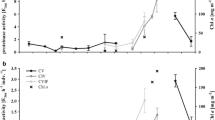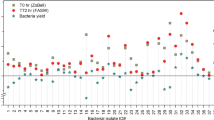Abstract
Chionoecetes opilio and Chionoecetes japonicus are closely related crab species that inhabit bathymetrically distinct habitats. C. opilio is caught mainly in waters shallower than 500 m, whereas C. japonicus largely resides at depths below 500 m. In this study, the activity of partially purified cellulase (β-1,4-glucanase) from the hepatopancreas of C. opilio (CoCel) and C. japonicus (CjCel) was investigated under high static pressure. SDS-PAGE-zymogram analysis revealed a major band in both species, with a calculated molecular mass of 41 kDa. In tests under various static pressures from 0.1 to 200 MPa, CoCel maintained 80 % of its activity up to 20 MPa, but activity decreased sharply to 20 % at 200 MPa in a pressure-dependent manner. In contrast, CjCel was less sensitive to high pressure, and maintained 65 % activity at 200 MPa. The activity of both CoCel and CjCel followed Michaelis–Menten kinetics at normal pressure levels; however, enzymatic activity of both CoCel and CjCel was suppressed in a non-competitive manner. These results suggest that CjCel, which can maintain normal activity under extremely high static pressure, have become highly adapted to the deep sea environment compared with CoCel.




Similar content being viewed by others
References
Yosho I, Hayashi I (1994) The bathymetric distribution of Chionoecetes opilio and C. japonicus (Majidae: Brachyura) in the western and northern areas of the Sea of Japan. Bull Jpn Sea Natl Fish Res Inst 44:59–71
Gibbs AG (1997) Biochemistry at depth. In: Randall DJ, Farrell AP (eds) Deep-sea fishes. Academic Press, London, pp 239–277
Somero GN (2003) Protein adaptation to temperature and pressure: complementary roles of adaptive changes in amino acid sequence and internal milieu. Comp Biochem Physiol B 136:577–591
Watanabe H, Tokuda G (2010) Cellulolytic systems in insects. Annu Rev Entomol 55:609–632
Watanabe H, Noda H, Tokuda G, Lo N (1998) A cellulase gene of termite origin. Nature 394:330–331
Smant G, Stokkermans JP, Yan Y, de Boer JM, Baum TJ, Wang X, Hussey RS, Gommers FJ, Henrissat B, Davis EL, Helder J, Schots A, Bakker J (1998) Endogenous cellulases in animals: isolation of β-1,4-endoglucanase genes from two species of plant-parasitic cyst nematodes. Proc Natl Acad Sci USA 95:4906–4911
Sugimura M, Watanabe H, Lo N, Saito H (2003) Purification, characterization, cDNA cloning and nucleotide sequencing of a cellulase from the yellow-spotted longicorn beetle, Psacothea hilaris. Eur J Biochem 270:3455–3460
Byrne KA, Lehnert SA, Johnson SE, Moore SS (1999) Isolation of a cDNA encoding a putative cellulase in the red claw crayfish Cherax quadricarinatus. Gene 239:317–324
Nishida Y, Suzuki K, Kumagai Y, Tanaka H, Inoue A, Ojima T (2007) Isolation and primary structure of a cellulase from the Japanese sea urchin Strongylocentrotus nudus. Biochimie 89:1002–1011
Suzuki K, Ojima T, Nishita K (2003) Purification and cDNA cloning of a cellulase from abalone Haliotis discus hannai. Eur J Biochem 270:771–778
Sakamoto K, Touhata K, Yamashita M, Kasai A, Toyohara H (2007) Cellulose digestion by common Japanese freshwater clam Corbicula japonica. Fish Sci 73:675–683
Niiyama T, Toyohara H (2011) Widespread distribution of cellulase and hemicellulase activities among aquatic invertebrates. Fish Sci 77:649–655
Kobayashi H, Hatada Y, Tsubouchi T, Nagahama T, Takami H (2012) The hadal amphipod Hirondellea gigas possessing a unique cellulase for digesting wooden debris buried in the deepest seafloor. PLoS One 7:e42727
Adachi K, Toriyama K, Azekura T, Morioka K, Tongnunui K, Ikejima K (2012) Potent cellulase activity in the hepatopancreas of mangrove crabs. Fish Sci 78:1309–1314
Jue C, Lipke P (1985) Determination of reducing sugars in the nanomole range with tetrazolium blue. J Biochem Biophys Methods 11:109–115
Ohmae E, Gekko K, Kato C (2015) Environmental adaptation of dihydrofolate reductase from deep-sea bacteria. In: Akasaka K, Matsuki H (eds) High pressure bioscience—basic concepts, applications and frontiers. Springer, Berlin, pp 423–442
Bradford MM (1976) Rapid and sensitive method for the quantitation of microgram quantities of protein utilizing the principle of protein-dye binding. Anal Biochem 72:248–254
Wong PT, Heremans K (1988) Pressure effects on protein secondary structure and hydrogen deuterium exchange in chymotrypsinogen: a Fourier transform infrared spectroscopic study. Biochim Biophys Acta 956:1–9
Murakami C, Ohmae E, Tate S, Gekko K, Nakasone K, Kato C (2011) Comparative study on dihydrofolate reductases from Shewanella species living in deep-sea and ambient atmospheric-pressure environments. Extremophiles 15:165–175
Silva JL, Foguel D, Royer CA (2001) Pressure provides new insights into protein folding, dynamics and structure. Trends Biochem Sci 26:612–618
Eisenmenger MJ, Reyes-De-Corcuera JI (2009) High pressure enhancement of enzymes: a review. Enzym Microb Technol 45:331–347
Ohmae E, Miyashita Y, Kato C (2013) Thermodynamic and functional characteristics of deep-sea enzymes revealed by pressure effects. Extremophiles 17:701–709
Kawaida S, Kimura T, Toyohara H (2013) Habitat segregation of two dotillid crabs Scopimera globosa and Ilyoplax pusilla in relation to their cellulase activity on a marsh-dominated estuarine tidal flat in central Japan. J Exp Mar Biol Ecol 449:93–99
Linton SM, Shirley AJ (2011) Isozymes from the herbivorous gecarcinid land crab, Gecarcoidea natalis that possess both lichenase and endo-β-1,4-glucanase activity. Comp Biochem Physiol B 160:44–53
Cantarel BL, Coutinho PM, Rancurel C, Bernard T, Lombard V, Henrissat B (2009) The Carbohydrate-Active EnZymes database (CAZy): an expert resource for glycogenomics. Nucleic Acids Res 37:D233–D238
Yasuda T (1967) Feeding habit of the zuwaigani, Chionoecetes opilio elongatus, in Wakasa Bay-I: specific composition of the stomach contents. Nippon Suisan Gakkaishi 33:315–319
Yosho I (2009) Studies on biology and stock management of Beni-zuwai crab, Chionoecetes japonicus Rathbun, in the Sea of Japan. PhD dissertation, Tohoku University, Sendai, Japan
Acknowledgments
The authors would like to thank Professor Fumiyoshi Abe (Department of Chemistry and Biological Science, College of Science and Engineering, Aoyama Gakuin University) for his useful advice. The authors are grateful to Hideaki Yamada from the Tottori Fisheries Experimental Station for kindly providing the experimental samples for preliminary study. This work was supported in part by the Japan Society for the Promotion of Science Grants-in-Aid for Scientific Research (JSPS KAKENHI; Grant Number 26520308).
Author information
Authors and Affiliations
Corresponding author
Electronic supplementary material
Below is the link to the electronic supplementary material.
Rights and permissions
About this article
Cite this article
Adachi, K., Tanimura, K., Mitsui, T. et al. Cellulolytic activity in the hepatopancreas of Chionoecetes opilio and Chionoecetes japonicus: enzymatic adaptations to deep sea environment. Fish Sci 82, 835–841 (2016). https://doi.org/10.1007/s12562-016-1014-8
Received:
Accepted:
Published:
Issue Date:
DOI: https://doi.org/10.1007/s12562-016-1014-8




